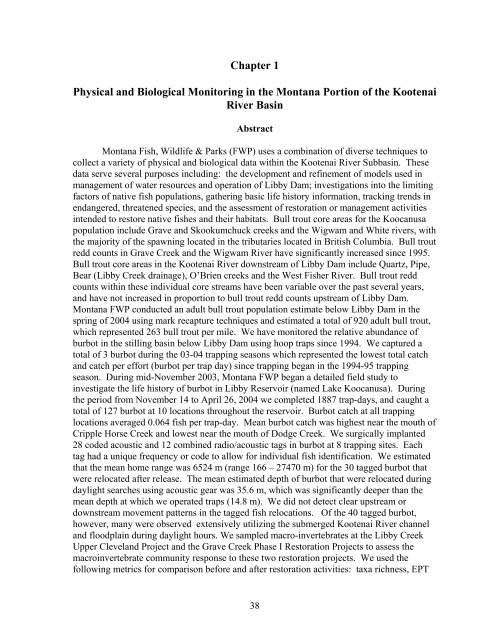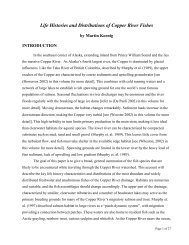Mitigation for the Construction and Operation of Libby Dam
Mitigation for the Construction and Operation of Libby Dam
Mitigation for the Construction and Operation of Libby Dam
You also want an ePaper? Increase the reach of your titles
YUMPU automatically turns print PDFs into web optimized ePapers that Google loves.
Chapter 1<br />
Physical <strong>and</strong> Biological Monitoring in <strong>the</strong> Montana Portion <strong>of</strong> <strong>the</strong> Kootenai<br />
River Basin<br />
Abstract<br />
Montana Fish, Wildlife & Parks (FWP) uses a combination <strong>of</strong> diverse techniques to<br />
collect a variety <strong>of</strong> physical <strong>and</strong> biological data within <strong>the</strong> Kootenai River Subbasin. These<br />
data serve several purposes including: <strong>the</strong> development <strong>and</strong> refinement <strong>of</strong> models used in<br />
management <strong>of</strong> water resources <strong>and</strong> operation <strong>of</strong> <strong>Libby</strong> <strong>Dam</strong>; investigations into <strong>the</strong> limiting<br />
factors <strong>of</strong> native fish populations, ga<strong>the</strong>ring basic life history in<strong>for</strong>mation, tracking trends in<br />
endangered, threatened species, <strong>and</strong> <strong>the</strong> assessment <strong>of</strong> restoration or management activities<br />
intended to restore native fishes <strong>and</strong> <strong>the</strong>ir habitats. Bull trout core areas <strong>for</strong> <strong>the</strong> Koocanusa<br />
population include Grave <strong>and</strong> Skookumchuck creeks <strong>and</strong> <strong>the</strong> Wigwam <strong>and</strong> White rivers, with<br />
<strong>the</strong> majority <strong>of</strong> <strong>the</strong> spawning located in <strong>the</strong> tributaries located in British Columbia. Bull trout<br />
redd counts in Grave Creek <strong>and</strong> <strong>the</strong> Wigwam River have significantly increased since 1995.<br />
Bull trout core areas in <strong>the</strong> Kootenai River downstream <strong>of</strong> <strong>Libby</strong> <strong>Dam</strong> include Quartz, Pipe,<br />
Bear (<strong>Libby</strong> Creek drainage), O’Brien creeks <strong>and</strong> <strong>the</strong> West Fisher River. Bull trout redd<br />
counts within <strong>the</strong>se individual core streams have been variable over <strong>the</strong> past several years,<br />
<strong>and</strong> have not increased in proportion to bull trout redd counts upstream <strong>of</strong> <strong>Libby</strong> <strong>Dam</strong>.<br />
Montana FWP conducted an adult bull trout population estimate below <strong>Libby</strong> <strong>Dam</strong> in <strong>the</strong><br />
spring <strong>of</strong> 2004 using mark recapture techniques <strong>and</strong> estimated a total <strong>of</strong> 920 adult bull trout,<br />
which represented 263 bull trout per mile. We have monitored <strong>the</strong> relative abundance <strong>of</strong><br />
burbot in <strong>the</strong> stilling basin below <strong>Libby</strong> <strong>Dam</strong> using hoop traps since 1994. We captured a<br />
total <strong>of</strong> 3 burbot during <strong>the</strong> 03-04 trapping seasons which represented <strong>the</strong> lowest total catch<br />
<strong>and</strong> catch per ef<strong>for</strong>t (burbot per trap day) since trapping began in <strong>the</strong> 1994-95 trapping<br />
season. During mid-November 2003, Montana FWP began a detailed field study to<br />
investigate <strong>the</strong> life history <strong>of</strong> burbot in <strong>Libby</strong> Reservoir (named Lake Koocanusa). During<br />
<strong>the</strong> period from November 14 to April 26, 2004 we completed 1887 trap-days, <strong>and</strong> caught a<br />
total <strong>of</strong> 127 burbot at 10 locations throughout <strong>the</strong> reservoir. Burbot catch at all trapping<br />
locations averaged 0.064 fish per trap-day. Mean burbot catch was highest near <strong>the</strong> mouth <strong>of</strong><br />
Cripple Horse Creek <strong>and</strong> lowest near <strong>the</strong> mouth <strong>of</strong> Dodge Creek. We surgically implanted<br />
28 coded acoustic <strong>and</strong> 12 combined radio/acoustic tags in burbot at 8 trapping sites. Each<br />
tag had a unique frequency or code to allow <strong>for</strong> individual fish identification. We estimated<br />
that <strong>the</strong> mean home range was 6524 m (range 166 – 27470 m) <strong>for</strong> <strong>the</strong> 30 tagged burbot that<br />
were relocated after release. The mean estimated depth <strong>of</strong> burbot that were relocated during<br />
daylight searches using acoustic gear was 35.6 m, which was significantly deeper than <strong>the</strong><br />
mean depth at which we operated traps (14.8 m). We did not detect clear upstream or<br />
downstream movement patterns in <strong>the</strong> tagged fish relocations. Of <strong>the</strong> 40 tagged burbot,<br />
however, many were observed extensively utilizing <strong>the</strong> submerged Kootenai River channel<br />
<strong>and</strong> floodplain during daylight hours. We sampled macro-invertebrates at <strong>the</strong> <strong>Libby</strong> Creek<br />
Upper Clevel<strong>and</strong> Project <strong>and</strong> <strong>the</strong> Grave Creek Phase I Restoration Projects to assess <strong>the</strong><br />
macroinvertebrate community response to <strong>the</strong>se two restoration projects. We used <strong>the</strong><br />
following metrics <strong>for</strong> comparison be<strong>for</strong>e <strong>and</strong> after restoration activities: taxa richness, EPT<br />
38
















